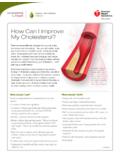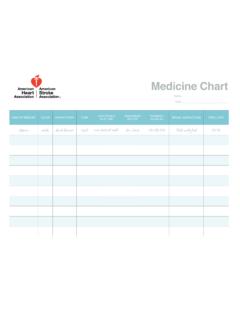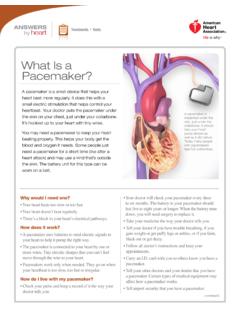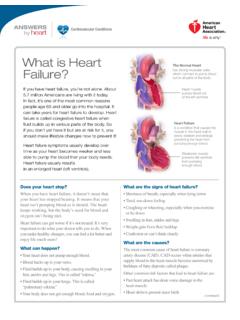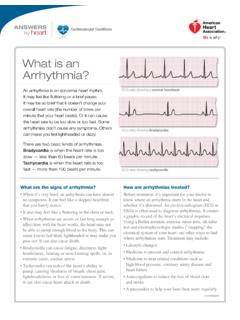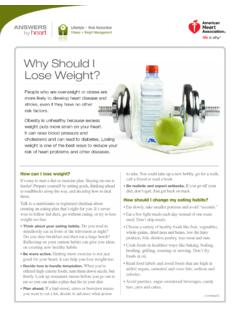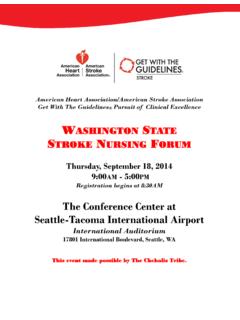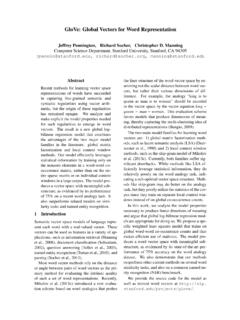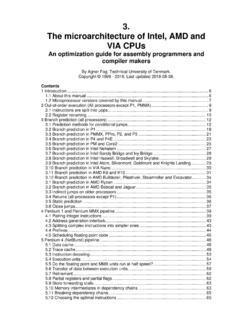Transcription of Triglycerides: Frequently Asked Questions
1 1 Triglycerides: Frequently Asked Questions Why are triglycerides important? The amount of triglycerides (or blood fats) in blood are one important barometer of metabolic health; high levels are associated with coronary heart disease, diabetes and fatty liver disease. Metabolism refers to the chemical process that converts the food we eat into the energy our cells need. Other measures of metabolic health that increase the risk of coronary heart disease include too much LDL cholesterol the bad cholesterol and too little HDL cholesterol the good cholesterol. Other important risk factors include total and LDL cholesterol. 1. What roles do triglycerides play in cardiovascular disease risk? Triglycerides provide unique information as a marker associated with the risk, for heart disease and stroke, especially when an individual also has low HDL- cholesterol (the good cholesterol) and elevated levels of LDL (the bad cholesterol).
2 -C. More research needs to be conducted to say that triglycerides are unequivocally an independent risk factor for CVD. Here s what we know so far: Case-control studies have shown that triglycerides could be an independent cardiovascular disease risk factor. A case-control study is an analytical study which compares individuals who have a specific disease ("cases") with a group of individuals without the disease ("controls"). The proportion of each group having a history of a particular exposure or characteristic of interest is then compared. Prospective population based cohort studies A recent study concluded that in younger persons the highest levels of triglycerides corresponded with a four times greater risk of heart disease and stroke risk compared to similar patients in the study who had the lowest levels of triglycerides.
3 (Tirosh et al, Ann Intern Med 2007) Clinical trials Although no clinical trials have been primarily designed to examine the effect of triglyceride reduction on heart attacks, stroke or other cardiovascular causes of death deaths, subgroups with high triglycerides tend to derive benefit when they receive therapies to lower their cholesterol levels. 2. How should individuals decrease triglycerides (TG)? Even if people have not been diagnosed with triglycerides outside the normal range, if they eat too many simple sugars (refined grains, added sugars and alcohol) their triglycerides will 2 increase. Everyone whether or not they have high triglycerides -- should focus on fiber-rich complex carbohydrates, such as vegetables and whole grains, instead of simple sugars.
4 Here are some important lifestyle habits to keep triglycerides low and lower triglycerides if they are above the normal range: Lose weight there is evidence that a 5-10 percent weight loss results in a 20 percent decrease in triglycerides the magnitude of decrease in triglycerides are directly related to the amount of weight lost. Monitor the quality of foods you eat A healthy eating pattern limits intake of sodium (salt), solid fats (such as full fat dairy products, meat and some tropical oils, such as coconut oil), added sugars, and refined grains and emphasizes more nutritious foods and beverages vegetables, fruits, fiber-rich whole grains, fat-free or low-fat milk and milk products, seafood, lean meats and poultry, beans, nuts and seeds. The type of carbohydrates that you eat makes a difference Foods that contain high amounts of simple sugars, especially fructose raise triglyceride levels.
5 Saturated and Trans fats raise triglycerides Unsaturated fats, especially omega-3 s that are found in fatty fish, lower triglyceride levels. Alcohol Alcohol in high amounts increases triglyceride levels in some people. In individuals with very high triglycerides, abstinence from alcohol is recommended in concert with reduced saturated fat intake. Physical Activity plays an important role in lowering triglycerides The effects that physical activity has on triglyceride levels vary depending upon baseline triglyceride level, level of intensity, caloric expenditure and duration of activity. 3. Is body fat distribution important? Visceral obesity is especially important because it is strongly associated with insulin resistance (an inability of the body to use insulin to convert food into energy) and high levels of triglycerides.
6 Visceral fat lies deep inside the abdomen, near the waistline surrounding the abdominal organs. The best way to lose this fat is to lose excess weight by eating a healthy diet along with getting regular physical activity. Physical activity helps reduce abdominal fat and preserve muscle during weight loss. The amount of physical activity to achieve a healthy weight varies from person to person. 4. What does the AHA recommend for hypertriglyceridemia? Factors such as body weight, body fat distribution, weight loss, and the type and amount of dietary carbohydrate and fat, as well as alcohol consumption play an important role in treating high levels of triglycerides. The AHA recommends changes in lifestyle habits as the main therapy for hypertriglyceridemia. These are the changes you need to make: If you're overweight, cut down on calories to reach your ideal body weight.
7 This includes all sources of calories, from fats, proteins, carbohydrates and alcohol. Reduce the saturated fat, trans fat and cholesterol content of your diet. 3 Reduce your intake of alcohol. Even small amounts of alcohol can lead to large changes in plasma triglyceride levels. Eat fruits, vegetables and nonfat or low-fat dairy products most often. Get at least 30 minutes of moderate-intensity physical activity on five or more days, for a total of at least 150 minutes per week. People with high triglycerides should substitute monounsaturated and polyunsaturated fats such as those found in canola oil, olive oil or liquid margarine for saturated fats. Substituting carbohydrates for fats may raise triglyceride levels and may decrease HDL ("good") cholesterol in some people.
8 Keep dietary fat to 25-35% of total diet. o If you eat many complex carbohydrates, as demonstrated by DASH (Dietary Approaches to Stop Hypertension, ) dietary eating plan, you ll be on the low end of the total fat range. Some people may wish to stay near the high end of the range in order to decrease triglycerides. These individuals must be sure to incorporate healthy fats into their eating pattern. Although the DASH diet was originally developed as a diet to lower blood pressure, the American Heart Association recommends it as an example of a healthy dietary pattern. o In order to incorporate healthy fats into the diet, substitute fish that is high in omega-3 fatty acids for meats high in saturated fat, such as steak or hamburger. Fatty fish like salmon, herring, sardines, lake trout, and albacore tuna are high in omega-3 fatty acids.
9 Control high blood pressure and avoid cigarette smoking. If a patient is taking drugs as prescribed by his or her healthcare provider to treat hypertriglyceridemia, dietary management is still important because, combined with drug therapy, lifestyle changes such as weight loss, increased physical activity and dietary modifications are highly effective and work well in concert with drug therapy. Patients should follow the specific plans laid out by their physicians, dietitians and nutritionists. 5. Do high-carbohydrate diets increase triglycerides and risk for cardiovascular disease? Evidence from a statement released by the National Heart, Lung and Blood Institute, panel on Detection, Evaluation, and treatment of High Blood Cholesterol in Adults (ATP III), suggests that very high intakes of carbohydrates (CHO) (greater than 60 percent of total calories) are accompanied by a rise in triglycerides.
10 The recommendation by ATP III regarding dietary Carbohydrate intakes should be limited to 60 percent of total calories. Lower intakes ( , 50 percent of calories) should be considered for persons with metabolic syndrome who have elevated triglycerides or low HDL cholesterol (the good cholesterol). 4 6. What is metabolic syndrome? The metabolic syndrome is defined by a cluster of easily measured metabolic factors, which occur together. Metabolic syndrome occurs when a person has 3 or more of the following 5 factors: elevated waist circumference, elevated triglycerides, reduced HDL-C, elevated blood pressure, elevated fasting glucose. Metabolic syndrome develops in the setting of excess calories and a sedentary lifestyle with underlying causes being obesity and insulin resistance.
